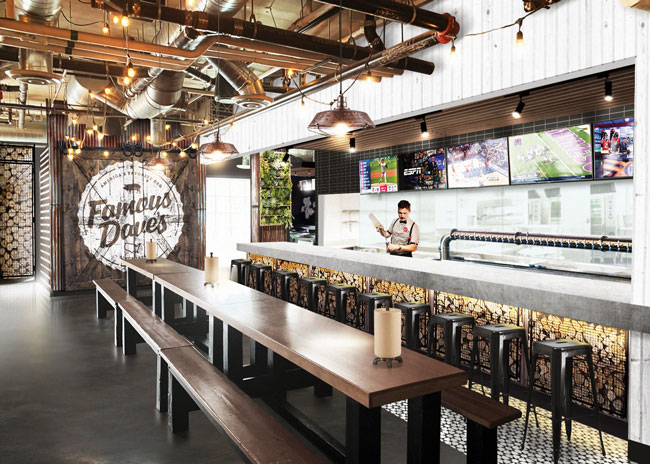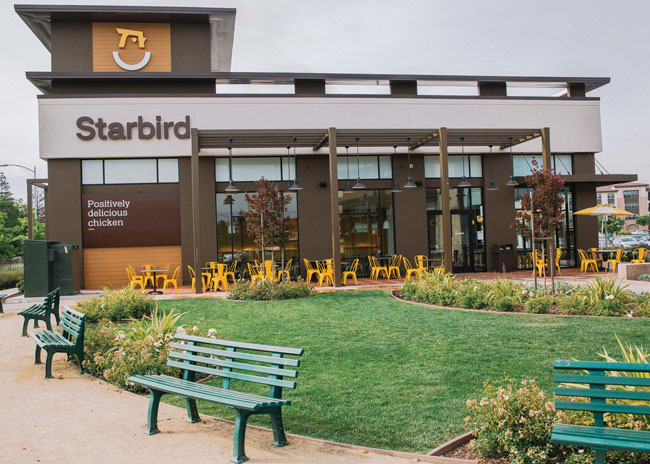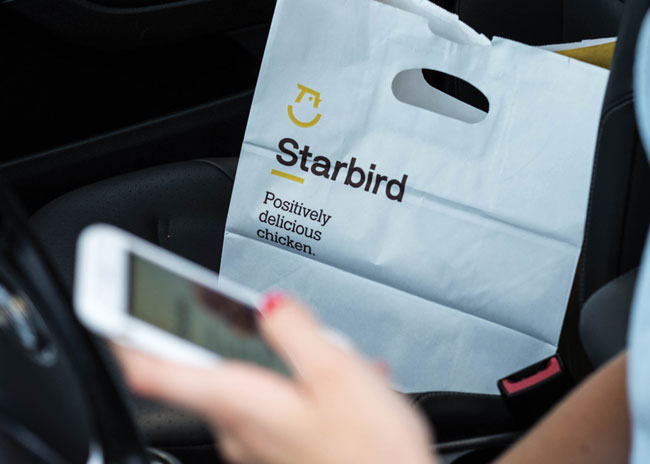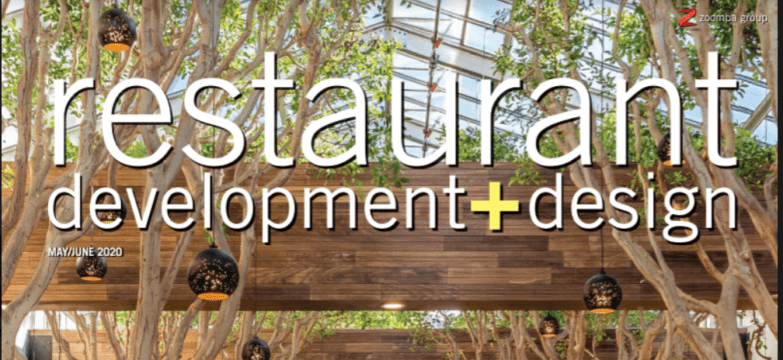After the COVID-19 pandemic forced the closure of thousands of restaurants and other foodservice operations nationwide, many businesses had to quickly shift gears and figure out if revenues from takeout and delivery would be enough to sustain the company through stay-at-home orders or if it made better financial sense to close completely. Some did both to see which worked.
As of mid-April, most restaurant dining rooms across the country remained closed without a clear indication of when they would reopen. And no one knows what the industry landscape will look like when they do.
One thing seems to be certain: Off-premises dining was becoming a big deal before the pandemic, and it will likely be an even bigger deal after.
“Off-premises — meaning preparing food for pickup, delivery and catering through internal platforms and through our third-party delivery providers — is something we have been working on and something that’s been part of our culture since Day One,” says Al Hank, senior vice president of operations for Famous Dave’s, a 20-year-old Minnetonka, Minn.-based barbecue chain with 120 locations. “Five years ago, off-premises sales made up 30% of our revenue, and last year that figure was nearing 50%.”
Of course, in the wake of mandated dining room closures intended to slow the spread of COVID-19, that number accelerated to 100%. Famous Dave’s quickly rolled out its curbside delivery program after testing it at six locations. Extra parking spaces were designated for curbside pickup; parking lot attendants — practicing social distancing — were set up with walkie-talkies to communicate with staff inside; the online ordering platform was updated so customers could input car details and pay for their meals ahead of time; and the to-go menu was adjusted to offer bulk meals and larger family platters that the chain would otherwise route through its catering program.
“I feel like we were well-positioned for what will become standard operating procedure for many restaurants in the future,” Hank says.
Like many restaurants, Starbird Chicken capitalized on the off-premises upswing at the start of the pandemic. “Having a strategy for off-premises is critically important now and will be in the future,” says Aaron Noveshen, founder of the six-unit fast-casual chain that serves the San Francisco area. Noveshen is also the founder and CEO of The Culinary Edge, a restaurant consultancy.
But designing for off-premises dining isn’t just about curbside pickups. These operators tell us that the pandemic has already had other effects on their operations and the ways they will work with architects, designers, consultants and other players in the future.

In the wake of COVID-19, Famous Dave’s quickly added curbside pickup and made improvements to its online ordering platforms. Image courtesy of Famous Dave’s
Double Make Lines and Pickup Stations
Many restaurants, like Starbird Chicken, already had double food production line setups before the pandemic, but this could become a staple in most kitchens as off-premises business continues to grow.
“With two lines, we can break up our production in a lot of ways, whether we designate one line just for dine-in and the other for takeout, or one for takeout and dine-in and the other for delivery only,” says Noveshen.
Before the pandemic, Starbird had begun to build pickup cubbies at the end of one of the production lines near the takeout-only door. Don’t be surprised, though, if these cubbies become more elaborate in the future with temperature controls or passcode-enabled locks.
Famous Dave’s likewise already had two production lines. The chain designates its rapid pickup station to handle off-premises and catering orders. Staff sort prepaid orders alphabetically by name on a heated shelf at the end of the line.
Separate Entrances and Drive-Thru
Before the COVID-19 outbreak, separate entrances for pickup and dine-in already helped manage traffic flow and reduce bottlenecks at both Famous Dave’s and Starbird. Now, in the age of social distancing, these will be imperative.
At Starbird, the entrance for pickup orders sits closer to the front of the building so customers and drivers can easily come in, grab their bags and go. Starbird’s dine-in door is set off to the side toward the rear of the restaurant, limiting the commingling between dine-in and off-premises customers. During the forced dining room closure, Noveshen says the restaurant has used the closed dining space to set bags on 6-foot-long tables and have runners bring the food to customers in cars or waiting outside. “We play music outside while they wait for their name to be called,” he says.
During dine-in closures, the Famous Dave’s team had to rewire POS stations and install plexiglass closer to the doorway for any walk-ins. Hank says he wouldn’t be surprised by the use of more of this separation between restaurant staff and customers in the future.
The Famous Dave’s team has also begun testing a makeshift drive-thru setup, with five locations using cones and signs to manage curbside pickup traffic. “In the future, I think the external design of the restaurant will become more important; we will see more parking spaces designated for curbside pickup,” Hank says. Don’t rule out more restaurants, including those in the casual-dining segment, adding a drive-thru or a hybrid drive-thru/curbside pickup option.

Based in the San Francisco Bay area, Starbird has used its dining room as a staging area for curbside delivery during the mandated dining room closures. Image courtesy of Starbird
Integrated, Contactless Ordering and Digital Real Estate
Before the pandemic, many restaurants were beginning to enhance their online ordering platforms and integrate them with their POS systems. Here again, the pandemic seems to have dramatically sped up this trend. Almost immediately when restaurants closed, Hank says he went to Famous Dave’s integrated ordering and delivery platform provider to add extra features for curbside pickup. Now information such as the make and model for cars picking up the meal gets printed on guest checks to direct team members to the proper vehicle.
To help streamline the process and reduce physical touch points along the way, all orders go directly from customers’ devices, third-party delivery sites or the restaurant’s in-house ordering systems straight to the kitchen display screens. The restaurant also posts signage and messaging throughout its restaurants and online to encourage customers to order — and prepay — without having to hand over a credit card. Payment scanners, though, do have contactless credit card reading capability.
Prior to the pandemic, Noveshen says Starbird Chicken had already created sub-brands, such as Starbird Wings and Starbird Salad, prepared out of its main restaurants or a ghost kitchen, to enhance the restaurant’s digital real estate on third-party delivery sites.
“If I am looking for a salad, Starbird Salad will come up sooner on that search than if I just searched Starbird,” Noveshen says. “When designing a restaurant, these days and going forward, you have to think about how people are contacting and finding you.”
Showcasing Safety and Sanitation
As restaurant dining rooms reopen, consumers will come back, but they will want some reassurance around safety. Sanitation and social distancing are key for restaurants, and these will have to be clearly demonstrated going forward, according to a survey from Chicago-based market research firm Datassential. In a study of what restaurants can do to make customers feel safe when they reopen, 71% of consumers surveyed said that regularly and visibly wiping down tables, kiosks and other things people touch is “absolutely required.”
Enhanced safety and sanitation efforts could have an effect on design, too. Of those surveyed, 57% said they would like to see more food covers, sneeze guards and enclosed cold cases; 54% said they would like to see disinfectant wipes on hand “for me to use.”
At Starbird, which uses kiosks for in-store ordering, Noveshen says they have quickly made space for a built-in sanitizing wipe station so customers will be able to wipe down surfaces like they might with their carts at a grocery store. Architects and designers might also consider no-touch handles beyond faucets, soap dispensers and dryers in bathrooms to include even door handles in the future.
Datassential also reported that consumers seem to be most concerned about how food is prepared (41%), followed by how the food was delivered (30%) and how the food was packaged (29%). If open kitchens were a popular thing in the past, now, they’ll need to be even more open — with staff possibly donning gloves and masks — in view.
Noveshen says Starbird is taking a second look at the use of pagers or other handheld devices and is reviewing self-service beverage and condiment stations. “Either we will need more automated equipment or there will need to be more dining room attendants visibly cleaning surfaces,” he says.
Downsized Dine-In
Many designers agree that dine-in won’t go away completely, but it’s not out of this world to think that some restaurants might consider downsizing those spaces.
“We had already been in the process of downsizing our restaurant from 6,000 to 7,000 square feet down to 3,500 square feet with a focus on enhanced efficiencies,” Hank says. “Right now, a lot of our dining rooms have become a storage closet for the extra packaging supplies we’ve needed.”
The chain has also reconfigured space in the back of the house to make room for more bulk-cooked meals and an expanded catering program with boxed lunches and meals that can be easily packaged and delivered to healthcare workers, first responders and the community via the company’s catering trucks. There’s also a need for more prep space to cook, chill and package larger family meals, and reheat items for the next day or that week.
It’s hard to know exactly what the long-term impacts of the pandemic will be, but moving forward, many elements of restaurant design will likely look the same with shifts to emphasize convenience and cleanliness. These elements of design will play a critical role in improving operations, efficiencies and revenue streams to rebuild the restaurant industry.

Starbird was optimized for third-party delivery platform search functions before the pandemic. Making it as easy as possible for customers to find what they want when looking for delivery and takeout options creates a competitive advantage. Image courtesy of Starbird
Filling the Urban Restaurant Void with Ghost Kitchens
Celebrity chef David Chang’s delivery-only ghost kitchen, Maple, closed in 2017 after just two years in business. Maybe he was a bit ahead of the curve. Prior to the coronavirus pandemic, some chains were already seeing successes with a ghost kitchen setup. And commissary kitchen operators like Kitchen United and CloudKitchens, which support the likes of Sweetgreen and Starbird Chicken, were just beginning to see investments.
That could all move into overdrive.
Joe Schumaker, FCSI, founder of FoodSpace, a foodservice design consultancy, has long envisioned ghost or virtual kitchens as the next wave for restaurants. Now, in a post-COVID-19 world, he says they present vital opportunities for architects.
“There might be many restaurants that will never reopen after this,” Schumaker says. “What is going to happen to all of those dead kitchens? What if these spaces could be used as ghost kitchens? All of the infrastructure is there — the equipment, the hoods and the dining space, which could be converted into more cold and dry storage and prep space.”
Depending on location, however, it’s not that simple, says Schumaker, who works with clients in the San Francisco Bay Area. Many municipalities zone ghost kitchens and commissaries differently than restaurants. Converting dead restaurants (zoned as retail spaces) into a ghost kitchen or commissary (zoned as a commercial, light industrial or mixed-use space) could require new operating permits, or they might not be allowed at all, depending on the neighborhood. “The parking ratios and land use requirements are very different for different zones, and it can be a very public and expensive process to get zoning changed,” says Schumaker.
That’s where architects come in. “It’s tough, but they might be able to champion zoning changes,” Schumaker says. “Ultimately, governments will need to step in and make things easier.” And then there’s the political game with real estate developers and landlords; charging rent for retail-zoned spaces can bring in far more revenue than a light industrial space.
One solution for restaurants looking to convert to a ghost kitchen while avoiding zoning issues could be to build a hybrid space — one that operates mostly as a ghost kitchen or commissary at the back but has a public-facing, storefront pickup area — enough to be considered a retail space. Picture pizza chains with limited or no seating and a heavy pickup and delivery program. Either way, Schumaker says, “it’s a lot easier to reconfigure existing kitchens and buy some new equipment here or there as opposed to starting from scratch in a warehouse. Shrinking the dining room but staying open to the public and expanding the back kitchen presents a new, potentially very successful business model for both struggling restaurants and new operators.”
Experts Weigh In on the Future of Restaurant Design
Griz Dwight
founder and principal, GrizForm Design Architects

Social distancing is here for now, and it looks like we will be practicing it for a while. In terms of restaurant design, we might see more loose tables and fewer banquettes and booths. Or it could be that we see restaurants including more intimate, secluded spaces by incorporating more four-top booths or private areas. As for bars, many may also opt for fewer barstools to give patrons more space to spread out. Regarding the back of the house, the need to change restaurant protocols will be much greater than the need to change design. The The back of the house is like a well-oiled machine, and if there’s a kink in the chain — say, someone out sick — there are usually major repercussions. There needs to be a change of internal protocols for those working in the back. Also, it doesn’t functionally make sense to make BOH spaces bigger in the sense of social distancing. For example, an extra two steps for a line cook can really harm speed and efficiency.
Dwayne MacEwen
founder and principal, DMAC Architecture

I think we’ll be taking a closer look at the functional aspect of air purification systems, as well as materials and coatings that reduce surface transmission of bacteria and viruses — all of which will become more important. This especially relates to menus and their design. Will the material change? What will they be made of in the future to be better cleaned between each use, similar to silverware? More efficiently planned BOH areas will yield more FOH square footage and therefore more space between seats. Adjacencies matter more than ever in terms of where the kitchen is and where servers bring the food out to the tables. It’s important to avoid redundant circulation, which makes for better service because the fewer the steps, the better the service and customer experience. While new controls may be put in place to address the spread of contagions, I don’t think we’ll see restaurant employees wearing masks in most venues — particularly if the restaurant has an open kitchen. However, sanitation will remain paramount. Additional solutions will include not just stacking equipment but sourcing more custom equipment with a smaller footprint.
David Shove-Brown
co-founder and partner, //3877

This pandemic has been a very extreme situation; however, I don’t believe this life is the new normal in the long term. Restaurants won’t necessarily have to rethink how they design to take social distancing into consideration — in fact, quite the opposite. Their protocol will likely be “we’re back in action; we need to repack the place with customers and celebrate our inherent yearning for gathering, eating, laughing and socializing.” That’s what the restaurant experience is all about. This pandemic has certainly increased our hyperawareness of the importance of good hygiene. In the restaurant industry, strict hygiene measures have been in place for a while, but restaurateurs are certainly going to be more cognizant of cleanliness and sanitation than before — there will likely be more rigid processes in place, or perhaps even people put in charge to specifically monitor these processes to ensure that sanitation is always prioritized. However, I don’t believe restaurants will need to necessarily decrease their seating capacity or extend their square footage, or that there will be new laws that require this change.
Matthew Mabie
president, Knoebel Construction, Inc.

From the conversations I am having with restaurant owners and franchisees, this event won’t change the kitchen. The real changes I am hearing with the design are more focused on carryout and delivery services. This has forced restaurants to expand that market and will lead to design changes — things as simple as building a safe and efficient side entrance, increasing the number of parking stall locations for curbside pickup and implementing double drive-thru lines, to name a few. I also wouldn’t be surprised to see layouts in the future that emphasize more of the dining space for takeout and delivery with more separation between the two. The situation right now is presenting some key opportunities for both design and construction to help operators gauge what their customers want and meet those needs. It’s a great opportunity for all brands to come back stronger than they were.
